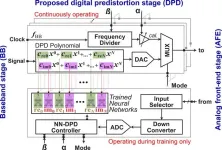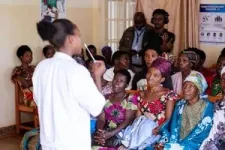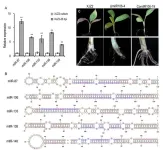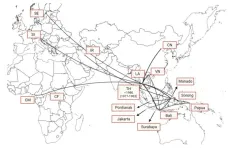(Press-News.org) In the world around us, a quiet but very important evolution has been taking place in engineering over the last decades. As technology evolves, it becomes increasingly clear that building devices that are physically as close as possible to being perfect is not always the right approach. That’s because it often leads to designs that are very expensive, complex to build, and power-hungry. Engineers, especially electronic engineers, have become very skilled in using highly imperfect devices in ways that allow them to behave close enough to the ideal case to be successfully applicable. Historically, a well-known example is that of disk drives, where advances in control systems have made it possible to achieve incredible densities while using electromechanical hardware littered with imperfections, such as nonlinearities and instabilities of various kinds.
A similar problem has been emerging for radio communication systems. As the carrier frequencies keep increasing and channel packing becomes more and more dense, the requirements in terms of linearity for the radio-frequency power amplifiers (RF-PAs) used in telecommunication systems have been getting stringent. Traditionally, the best linearity is provided by designs known as “Class A”, which sacrifice great amounts of power to maintain operation in a region where transistors respond in the most linear possible way. On the other hand, highly energy-efficient designs are affected by nonlinearities that render them unstable without suitable correction. The situation has been getting worse because the modulation systems used by the latest cellular systems have a very high power ratio between the lowest- and highest-intensity symbols. Specific RF-PA types such as Doherty amplifiers are highly suitable and power-efficient, but their native non-linearity is not acceptable.
Over the last two decades, high-speed digital signal processing has become widely available, economical, and power-efficient, leading to the emergence of algorithms allowing the real-time correction of amplifier non-linearities through intentionally “distorting” the signal in a way that compensates the amplifier’s physical response. These algorithms have become collectively known as digital pre-distortion (DPD), and represent an evolution of earlier implementations of the same approach in the analog domain. Throughout the years, many types of DPD algorithms have been proposed, typically involving real-time feedback from the amplifier through a so-called “observation signal”, and fairly intense calculations. While this approach has been instrumental to the development of third- and fourth-generation cellular networks (3G, 4G), it falls short of the emerging requirements for fifth-generation (5G) networks, due to two reasons. First, dense antenna arrays are subject to significant disturbances between adjacent elements, known as cross-talking, making it difficult to obtain clean observation signals and causing instability. The situation is made considerably worse by the use of ever-increasing frequencies. Second, dense arrays of antennas require very low-power solutions, and this is not compatible with the idea of complex processing taking place for each individual element.
“We came up with a solution to this problem starting from two well-established mathematical facts. First, when a non-linearity is applied to a sinusoidal signal, it distorts it, leading to the appearance of new frequencies. Their intensity provides a sort of signature, that, if the non-linearity is a polynomial, is almost univocally associated with a set of coefficients. Second, multi-layer neural networks, of the early kinds, introduced decades ago, are universal function approximations, therefore, are capable of learning such an association, and inverting it,” explains Prof. Ludovico Minati, leading inventor of the patent on which the study is based and formerly a specially-appointed associate professor at Tokyo Tech.
The most recent types of RF-PAs based on CMOS technology, even when they are heavily nonlinear, tend to have a relatively simple response, free from memory effects. “This implies that the DPD problem can be reduced to finding the coefficients of a suitable polynomial, in a way that is quick and stable enough for real-world operation,” explains Dr. Aravind Tharayil Narayanan, lead author of the study. Through a dedicated hardware architecture, the engineers at the Nano Sensing Unit of Tokyo Tech were able to implement a system that automatically determines the polynomial coefficients for DPD, based on a limited amount of data that could be acquired within the course of a few milliseconds. Performing calibration in the “foreground”, that is, one path at a time, reduces issues related to cross-talk and greatly simplifies the design. While there is no observation signal needed, the calibration can adjust itself to varying conditions through the inputs of additional signals, such as die temperature, power supply voltage, and settings of the phase shifters and couplers connecting the antenna. While standards compliance may pose some limitations, the approach is in principle widely applicable.
“Because there is very limited processing happening in real-time, the hardware complexity is truly reduced to a minimum, and the power efficiency is maximized. Our results prove that this approach could in principle be sufficiently effective to support the most recent emerging standards. Another very convenient feature is that a considerable amount of hardware can be shared between elements, which is particularly convenient in dense array designs”, added Prof. Hiroyuki Ito, head of the Nano Sensing Unit of TokyoTech where the technology was developed. As a part of an industry-academia collaboration effort funded by NEDO, the authors were able to test the concept on realistic, leading-edge hardware operating at 28 GHz provided by Fujitsu Limited, working in close collaboration with a team of engineers in the Product Planning Division of the Mobile System Business Unit. Future work will include large-scale implementation using dedicated ASIC designs, detailed standards compliance analysis and realistic benchmarking on the field under a variety of settings.
An international PCT application for the methodology and design has been filed, and the related results are reported in a recent article published in the prestigious journal IEICE Electronics Express [1,2].
###
References:
[1] PCT/JP2022/038955, SYSTEM FOR COMPENSATING THE NON-LINEAR DISTORTION INTRODUCED BY A RADIO POWER AMPLIFIER BASED ON HARMONIC ANALYSIS
[2] A.T. Narayanan, L. Minati, A. Hagihara, J. Kobayashi, T. Shimura, Y. Kawano, P. Chakraborty, J. Bartels, K.K. Tokgoz, S. Dosho, T. Suzuki, H. Ito. A Neural Network-Based DPD Coefficient Determination for PA Linearization in 5G and Beyond-5G mmWave Systems. IEICE Electronics Express, Vol.VV, No.NN, pp.1–6, April 2024. DOI :10.1587/elex.21.20240186
###
About Tokyo Institute of Technology
Tokyo Tech stands at the forefront of research and higher education as the leading university for science and technology in Japan. Tokyo Tech researchers excel in fields ranging from materials science to biology, computer science, and physics. Founded in 1881, Tokyo Tech hosts over 10,000 undergraduate and graduate students per year, who develop into scientific leaders and some of the most sought-after engineers in industry. Embodying the Japanese philosophy of “monotsukuri,” meaning “technical ingenuity and innovation,” the Tokyo Tech community strives to contribute to society through high-impact research.
https://www.titech.ac.jp/english/
END
BINGHAMTON, N.Y. -- Worker rights are among the least protected human rights in the world, according to new research from faculty at Binghamton University, State University of New York.
The findings are part of a new report published by the CIRIGHTS Data Project, the largest human rights dataset in the world. Since 1981, the project has ranked countries around the world on their respect for human rights, providing an annual “report card” on 25 internationally recognized human rights. The project ...
Fusarium oxysporum f. sp. cubense (Foc) is a typical soil-borne fungus that causes Fusarium wilt by infecting the roots and blocking the vascular tissues of host banana, and threatens the global banana production. Total four races have been reported in Foc, of which the tropical race 4 (TR4) is the most widespread race. In some severely affected banana plantations, the conventional ‘Cavendish’ variety had to be abandoned for other alternative crops due to the spread of TR4. Therefore, a comprehensive understanding of the pathogenesis of FWB and the development ...
This study is led by Prof. Qunxin She (Shandong University) and Dr. Guanhua Yuan (Shandong University). The research group has constructed versatile genetic tools for Saccharolobus islandicus REY15A, one of the very few archaeal models for archaea biology and CRISPR biology research, and these include efficient genome editing, robust protein expression systems, interference plasmid assay, gene silencing and CRISPR-based gene editing. Nevertheless, plasmid vectors constructed for this crenarchaeon thus far are based solely on the pRN2 cryptic plasmid. “A dual host-vector system is required to enrich the genetic toolbox for this model archaeon.” the ...
As kimchi has been drawing attention as a global healthy food trend, cabbage is one of the representative vegetables used as a main ingredient for manufacturing kimchi overseas.
The annual global production of cabbage and other Brassica crops is reported to be 72 million tons, and more than 30% of them are estimated to be discarded during the manufacturing and distribution processes, causing environmental pollution as well as considerable waste disposal costs in the industry.
In connection with this problem, Hae Choon Chang, President of the World Institute of Kimchi (WiKim), a government-funded research institute under the Ministry of Science and ICT, announced on April 22 that ...
Every day our brains strive to optimize a trade-off: With lots of things happening around us even as we also harbor many internal drives and memories, somehow our thoughts must be flexible yet focused enough to guide everything we have to do. In a new paper in Neuron, a team of neuroscientists describes how the brain achieves the cognitive capacity to incorporate all the information that’s relevant without becoming overwhelmed by what’s not.
The authors argue that the flexibility arises from a key property observed in many neurons: “mixed selectivity.” While many neuroscientists used to think each cell had just one dedicated function, more recent evidence ...
The HIV variant dominant in Indonesia was introduced from Thailand over multiple events. The Kobe University study traces where it came from and how it spread from there, offering insights of possible value to the development of treatments against the disease.
HIV is the virus causing AIDS, but one of the things that make it so difficult to treat is that there are many variants of it. Kobe University virologist KAMEOKA Masanori says, “The diversity is increasing every day and the prevalent virus strains differ from region to ...
Researchers at the University of California San Diego School of Medicine have shed new light on the changes in metabolism that occur between birth and the presentation of autism spectrum disorder (ASD) later in childhood. The researchers discovered that a small number of biochemical pathways are responsible for the majority of these changes, which could help inform new early detection and prevention strategies for autism.
“At birth, the physical appearance and behavior of a child who will develop autism over the next few years are indistinguishable from that of a neurotypical child. Indeed, in most cases the fate of the child with regard to autism is not ...
Advancements in large language models, robotics, and software such as text-to-speech, have made it possible to develop robots that can understand language, interact physically, and communicate verbally. These breakthroughs have opened up possibilities for robots to be used for educational purposes. However, this raises the question of whether robots are as good as human tutors. While robots offer certain benefits, they cannot replicate the nuanced interactions and personalized feedback human tutors provide.
To determine the suitability of using ...
Extreme exercise doesn’t seem to shorten the lifespan as is widely believed, suggest the findings of a study on the longevity of the first 200 athletes to run a mile in under 4 minutes, and published online in the British Journal of Sports Medicine.
They outlive the general population by several years, shows the study, which marks the 70th anniversary of the seminal achievement of Roger Bannister, who was the first person to run a mile in under 4 minutes in May 1954.
While regular moderate exercise is considered a pillar of healthy ageing, ...
The British Journal of Sports Medicine has retracted six further articles authored by former editor, Dr Paul McCrory, and corrected another two, following an extensive investigation of his sole authored content in the journal.*
The retractions comprise four ‘warm up’ editorials and one book review due to plagiarism. A letter has also been retracted because of duplicate publication. And a research article and a review article have been corrected due to inappropriate reuse of content.
This latest tranche of retractions and corrections completes BMJ’s 2-year investigation ...







